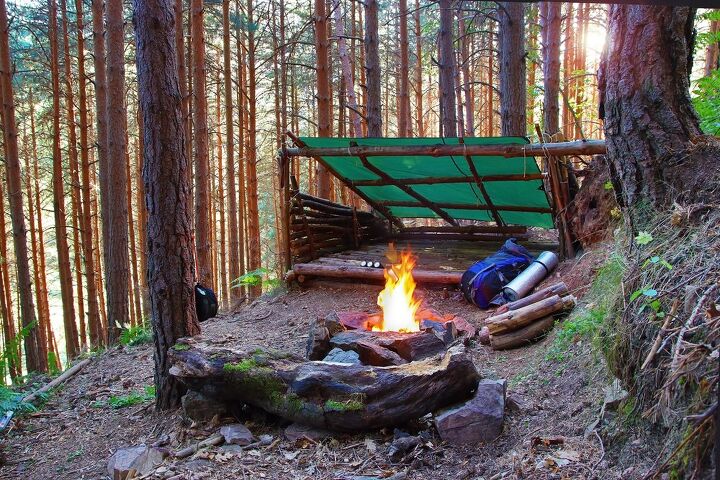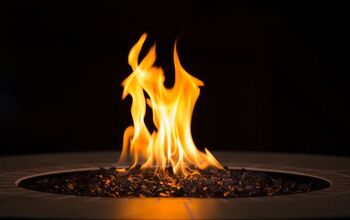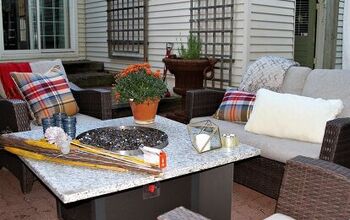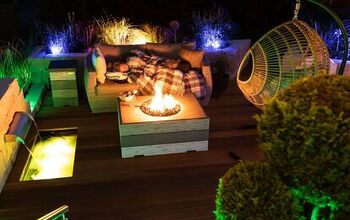Can You Put A Canopy Over A Fire Pit?

A raised fire pit in the backyard is a beautiful way to create an outdoor space that is both aesthetically pleasing and functional for parties or get-togethers. Putting a canopy over your fire pit can help protect the flame from the elements, but little is known about whether or not this is a safe practice.
Don’t put a regular canopy over a fire pit because of carbon monoxide poisoning and a fire hazard. It must have an opening at the top and be designed with flame-proof material to be deemed safe. Additionally, never start your fire with lighter fluid or leave the flame unattended.
Follow along to learn if it’s responsible to put a canopy over a fire pit and how to do so. Additionally, this article will cover what not to do when using a canopy over an open flame.
Do You Need Fire Protection and Prevention Services?
Get free, zero-commitment quotes from pro contractors near you.

Is It Safe to Put a Canopy Over a Fire Pit?
Canopies offer great benefits when it comes to keeping an area dry and in the shade. However, are they a good idea in areas where you’re also burning a fire pit?
Generally speaking, it’s unsafe to use any old canopy over a fire pit. However, some companies, like Campfire Canopy, specifically design their tents with material to be used with an open flame.
It’s important to make sure that the canopy has a hole at the top of the structure; that way, the carbon dioxide and smoke can escape as they normally would. If there’s no hole, the tent will collect smoke and ash, creating an unsafe environment for you and your guests.
Additionally, the base of a fire pit shouldn’t be touching wood or any material that isn’t stable and properly flame-proofed. It’s pivotal that you’re paying attention to the fire at all times.
How to Use a Canopy Over a Fire Pit
As previously mentioned, it’s important that the canopy has a hole at the top and that nothing touches the bottom of your fire pit. However, there are other factors you should consider to ensure optimal safety.
To use a canopy over a fire pit:
- Make sure you have a fire extinguisher nearby.
- Check for the hole at the top of the canopy before placing your fire pit inside.
- Start your fire.
- Smother any embers that may fall outside of the hole into the canopy-covered area.
- Be extra careful when removing or moving your canopy, so you don’t cause a fire hazard.
- Encourage your guests to use caution when navigating underneath the canopy.
- Remove the canopy before putting out the fire, as excess smoke could crowd the tent.
- Put the fire out immediately after you finish using it.
By following these tips, you can safely enjoy a canopy over a fire pit with your friends and family.
What Not to Do When Using a Canopy Over a Fire Pit
Now that you know how to use a canopy properly, let’s take a look at what not to do. Adhering to these guidelines is crucial to keeping yourself and your house guests safe in the event of an emergency.
Here’s what you should avoid when using a canopy over a fire pit:
- Never use a canopy over an open flame that is not specifically designed for this purpose (i.e., ones without an opening at the top).
- Do not put the base of your fire pit in direct contact with any flammable materials like wood.
- Don’t use lighter fluid to start the fire; this can generate a flame that’s out of control and will quickly spread to the canopy canvas.
- Never leave a lit fire unattended.
- Do not expect the canopy to block out all of the elements of inclement weather, including rain and snow. Be sure to properly take down your canopy before the weather becomes dangerous.
- Do not use the canopy poles to help move or shift the fire pit, as these can melt if they come into contact with high heat.
- Avoid using the fire pit when it’s windy, as this can cause sparks to fly out of control.
Safety is the most important aspect of any situation, including using a canopy over an open fire pit. Don’t cut corners when caring for your guests, and you’ll have nothing to worry about!
Related Questions
Can you put a fire pit under a gazebo?
You should never put a fire pit under a gazebo for safety reasons. The heat and sparks from the fire pit could easily ignite the wood elements of the structure.Additionally, trapping smoke in an enclosed area is dangerous. It can cause carbon monoxide poisoning and other respiratory problems. In order to do this safely, you need some sort of additional ventilation.
Should fire pits have a drainage hole?
Built-in fire pits must have a mechanism to drain moisture, such as a drainage hole or pipe. Otherwise, when it rains, water will collect inside of the pit and render it useless.Excessive water sitting in your fire pit can also damage the internal electrical components that enable you to light the machine. That’s why it’s important to have a way to get rid of it.
Can you put a fire pit on grass?
Yes, you can place a fire pit on grass, but it’s best to use a flame-proof mat beneath in order to prevent a safety hazard and protect the vegetation.Additionally, make sure to water the grass around the pit so that it doesn’t catch fire. If you take the necessary precautions, you can enjoy this luxury without worrying about any negative consequences to you or your grass.
Do You Need Fire Protection and Prevention Services?
Get free, zero-commitment quotes from pro contractors near you.

Final Thoughts
If you want to enjoy the warmth and feel of a campfire without putting yourself or your house in danger, it’s crucial that you use caution.
By following these guidelines for using a canopy over an open fire pit, not only will you be able to avoid any potential hazards but also ensure that everyone has a good time.
So get your friends and family together, set up that fire pit, and enjoy the great outdoors!
Related Guide

Emily is a copywriter with over five years of experience in crafting content for the home renovation and remodeling industry. She loves house projects, whether it be painting a room or tweaking small design elements to transform a space. Her favorite aesthetic is french modern because of its clean lines and airy feeling! When not writing, Emily loves to travel and check out architectural details all over the world.
More by Emily Carr



























